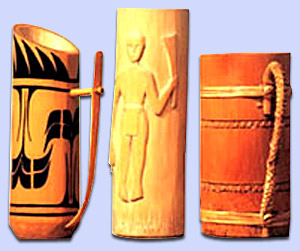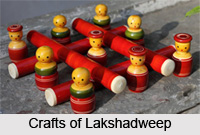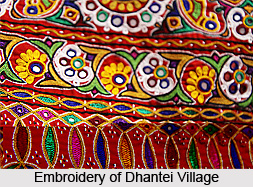 Embroidery of Gujarat has earned its fame because of the versatility of creations by the artisans. The most important centres of embroidery work of Gujarat are located in the Saurashtra and Kutch regions and are admired for the creative excellence.
Embroidery of Gujarat has earned its fame because of the versatility of creations by the artisans. The most important centres of embroidery work of Gujarat are located in the Saurashtra and Kutch regions and are admired for the creative excellence.
The artisans of Gujarat use an array of stitches that are used to decorate the items. The artisans use Abhala embroidery to ornate the fabric with small round pieces of mirrors using buttonhole stitching. This embroidery is done in a herringbone stitch using silken thread of rust, light green, indigo, blue, deep red, pink and purple colours. A special type of embroidery is used to ornate the fabrics that has its origin in Banni of Kutch. The base materials are embellished with mirrors and beads.
The embroidery of Gujarat is also famous for the embroidery that executes architectural designs known as the `heer bharat`. The stitch has gained this name from the floss-silk (heer). The stitch, almost three inches long runs parallel to the warp in one part of the motif and to the weft in the other giving it a natural texture. A mirror secured with chain-stitch in the center is placed to beautify the embroidery work. The items of this brocaded stitch are available in the shades of off-white, yellow, madder red, black, indigo, ivory, and green.
Embroidery of Gujarat includes Kathi embroidery, the oldest form of embroidery which is known for its romantic motifs. Geometrical motifs are fabricated with multicolored fabric pieces leading to a patch work effect. Saurashtra is the centre of Kathi embroidery done by the Kathi community. The women of this community have a fancy for black cloth embroidered in crimson, violet, golden, yellow and white in combination with greens and blues that render vibrancy and enhance the beauty of the item. The main stitch is based on a prolonged darn and chain-cum-interlacing. There are two forms of Kathi embroidery that includes Aditya Fatiya and Patch Work which are mostly used in embellishing wall hangings, door frames and other decorative items. Gureri is a popular item of Kathi Embroidery.
Besides these embroideries, the artisans of Gujarat create items using Ari embroidery with silk threads. This embroidery employs a hook for creating different motifs and patterns of dancing peacocks and human figures in dancing poses. Even Bandhani patterns decked with beautiful and delicate bead work is done with great artistry. People of different communities like Rabaris, Ahirs, Jats, Bharwads and Harijans in Gujarat are employed for the embroidery works who possess their own styles of embroidery. Jats and Mutuwas use cotton and quality silks to create different motifs and patterns on women`s outfits. The Rabari community creates their typical embroidery work embroidery on a maroon background with the enclosed motifs.
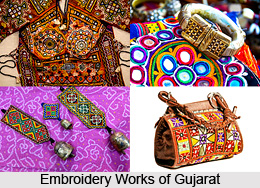
The embroidery of Gujarat is one of the main sources of income for different other communities. According to the popular saying, the Mochi community has learnt the art of embroidery from the Muslim craftsmen. They had mastered this art with their own adaptability and later they applied this embroidery on leather. These motifs are derived from Mughal and Persian arts and they also use designs that are based on animal forms. The people of Ahir and Rabari communities use vivid embroidery and mirror work to decorate the dark background of the fabrics. The mirrors are used to enhance the beauty of the items that are embroidered with dark coloured thread in herringbone or button-hole stitch. The Kanbis, the migrants from Saurashtra, prefer to use white, yellow or saffron base cloth for creating different items.
Apart from these artistic creations, the embroidery work including bead work which was imported from East Africa around 1850 and had been included in the Gujarat culture by the people of the Mochi community. Gradually the people, mainly the women folk of other communities adopted this artwork in their culture and started creating different items using thread and beads. In the religious ceremonies, weddings and festivals, the people of Gujarat use items of bead work that are the evidences of exquisite works of Gujarati embroidery. The artisans of Bhuj create the most strikingly vibrant leather panels using multicoloured threads, mirrors and cotton cloth. The raw materials for the embroidery work are derived from Ahmedabad and the mirrors are available in the village market. Both the men and women are engaged in making different items out of leather. While the men are engaged in making leather products, the women do the embroidery work on the created items.
The embroidery of Gujarat displays a wide variety of items ranging from garments to items of home decor. Toran is the embroidered doorway decoration with hanging flaps. The local people of Gujarat believe that it brings good luck to the household. Moreover, pachhitpatis which is hanged from the corners in the Gujarati households as a welcome symbol to the visitors; Chaklas that are used as furniture covers, a wall hanging called Bhitiya are also made by employing embroidery work. The artisans of this district are excelled in making cholis, gaghras, odhnis, bed spreads, bags, wall hanging and a variety of ornamental pieces for home decor. In addition to these, the artisans involved in the embroidery work of Gujarat,
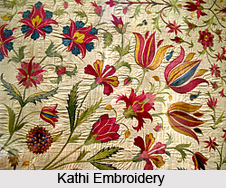 include Rabari embroidery which is considered to be the dazzling work and the artisans are adept in creating different items with this embroidery. The Kutchi Rabaris employ mirrors of different shapes and sizes in the creations.
include Rabari embroidery which is considered to be the dazzling work and the artisans are adept in creating different items with this embroidery. The Kutchi Rabaris employ mirrors of different shapes and sizes in the creations.
Applique or Katab is another form of decorative needlework which has gained appreciation in most of the regions of Gujarat. This is more noticeable in Saurashtra. This exclusive needlework is done with pieces of coloured and patterned fabric, which are very dexterously cut to make the motifs and patterns. These cut pieces are then stitched on to a plain background to make quilts, curtains and wall hangings.
The embroidery of Gujarat is highly praised for the distinct quality of raw material and the creations follow an excellent technique. The embroidery work done by the people of Gujarat thus displays the craftsmanship of the local artisans.



